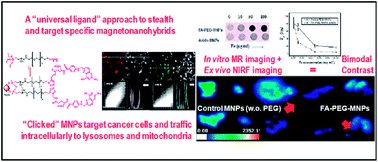Orthogonal biofunctionalization of magnetic nanoparticles via “clickable” poly(ethylene glycol) silanes: a “universal ligand” strategy to design stealth and target-specific nanocarriers†
Abstract
The present work demonstrates a novel strategy to synthesize orthogonally bio-engineered magnetonanohybrids (MNPs) through the design of versatile, biocompatible linkers whose structure includes: (i) a robust anchor to bind with metal-oxide surfaces; (ii) tailored surface groups to act as spacers and (iii) a general method to implement orthogonal functionalizations of the substrate via “click chemistry”. Ligands that possess the synthetic generality of features (i)–(iii) are categorized as “universal ligands”. Herein, we report the synthesis of a novel, azido-terminated poly(ethylene glycol) (PEG) silane that can easily self-assemble on MNPs through hetero-condensation between surface hydroxyl groups and the silane end of the ligand, and simultaneously provide multiple clickable sites for high density, chemoselective bio-conjugation. To establish the universal-ligand-strategy, we clicked alkyl-functionalized folate onto the surface of PEGylated MNPs. By further integrating a near-infrared fluorescent (NIRF) marker (Alexa-Fluor 647) with MNPs, we demonstrated their folate-receptor mediated internalization inside cancer cells and subsequent translocation into lysosomes and mitochondria. Ex vivo NIRF imaging established that the azido-PEG-silane developed in course of the study can effectively reduce the sequestration of MNPs by macrophage organs (viz. liver and spleen). These folate–PEG-MNPs were not only stealth and noncytotoxic but their dual optical and magnetic properties aided in tracking their whereabouts through combined magnetic resonance and optical imaging. Together, these results provided a strong motivation for the future use of the “universal ligand” strategy towards development of “smart” nanohybrids for theragnostic applications.


 Please wait while we load your content...
Please wait while we load your content...